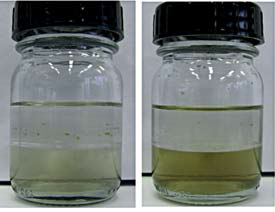Tổng hợp polyaniline theo phương pháp trùng hợp bề mặt với tác nhân tăng cường decylphosphonic acid
Tóm tắt
Polyaniline (PANI) được tổng hợp theo phương pháp trùng hợp bề mặt ở nhiệt độ phòng, sử dụng toluene làm pha hữu cơ để hòa tan aniline, chất oxy hóa ammonium persulfate (APS) và tác nhân tăng cường (doping) là decylphosphonic acid (DcPA) tan trong pha nước. Quá trình này được thực hiện tại Phòng Thí nghiệm Công nghệ Hóa dầu, Trường Đại học Bách khoa - Đại học Đà Nẵng. Nhóm tác giả đã sử dụng phổ hồng ngoại biến đổi Fourier (FT-IR) và phổ hấp thụ (UV-vis) để đánh giá đặc trưng cấu trúc phân tử của polyaniline thu được từ quá trình này (PANI-inter-DcPA). Sản phẩm có cấu trúc nano sợi đồng nhất với đường kính trung bình khoảng 50nm khi quan sát dưới kính hiển vi điện tử quét (SEM).
Các tài liệu tham khảo
D.Du, X.Ye, J.Cai, J.Liu, A.Zhang. Acetylcholinesterase biosensor design based on carbon nanotube-encapsulated polypyrrole and polyaniline copolymer for amperometric detection of organophosphates. Biosensors and Bioelectronics. 2010; 25(11): p. 2503 - 2508.
Q.Liu, M.H.Nayfeh, S.T.Yau. Brushed-on flexible supercapacitor sheets using a nanocomposite of polyaniline and carbon nanotubes. Journal of Power Sources. 2010; 195(21): p. 7480 - 7483.
L.He, Y.Jia, F.Meng, M.Li, J.Liu. Gas sensors for ammonia detection based on polyaniline-coated multi-wall carbon nanotubes. Materials Science and Engineering: B. 2009; 163(2): p. 76 - 81.
S.Bhadra, N.K.Singha, D.Khastgir. Polyaniline by new miniemulsion polymerization and the effect of reducing agent on conductivity. Synthetic Metals. 2006; 156(16 - 17); p. 1148 - 1154.
J.Unsworth, B.A.Lunn, P.C.Innis, Z.Jin, A.Kaynak, N.G.Booth. Technical review: Conducting polymer electronics. Journal of Intelligent Material Systems and Structures. 1992; 3(3): p. 380 - 395.
E.Kang. Polyaniline: A polymer with many interesting intrinsic redox states. Progress in Polymer Science. 1998; 23(2): p. 277 - 324.
J.Stejskal, P.Kratochvíl, A.D.Jenkins. The formation of polyaniline and the nature of its structures. Polymer. 1996; 37(2): p. 367 - 369.
S.Bhadra, D.Khastgir, N.K.Singha, J.H.Lee. Progress in preparation, processing and applications of polyaniline. Progress in Polymer Science. 2009; 34(8): p. 783 - 810.
Phan Thế Anh, Nguyễn Đình Lâm, François-XavierX Perrin. Tổng hợp polyaniline theo phương pháp trùng hợp nhũ tương đảo. Tạp chí Khoa học và Công nghệ, Đại học Đà Nẵng. 2011; 3(44), p. 12 - 19.
J. Huang, R.B.Kaner. A general chemical route to polyaniline nanofibers. Journal of American Chemical Society. 2004; 126 (3): p. 851 - 855.
X.Zhang, R.Chan-Yu-King, A.Jose, S.K.Manohar. Nanofibers of polyaniline synthesized by interfacial polymerization. Synthetic Metals. 2004; 145(1): p. 23 - 29.
J.Chen, D.Chao, X.Lu, W.Zhang. Novel interfacial polymerization for radially oriented polyaniline nanofibers. Materials Letters. 2007; 61(6): p. 1419 - 1423.
X.H.To, N.Pebere, N.Pelaprat, B.Boutevin, Y.Hervaud. A corrosion-protective film formed on a carbon steel by an organic phosphonate. Corrosion Science. 1997; 39(10 - 11): p. 1925 - 1934.
Y.Gonzalez, M.C.Lafont, N.Pebere, G.Chatainier, J.Roy, T.Bouissou. A corrosion inhibition study of a carbon steel in neutral chloride solutions by zinc salt/phosphonic acid association. Corrosion Science. 1995; 37(11): p. 1823 - 1837.
H.S.O.Chan, S.C.Ng, P.K.H.Ho. Polyanilines doped with phosphonic acids: Their preparation and characterization. Macromolecules. 1994; 27(8): p. 2159 - 2164.
J.Stejskal, R.G.Gilbert. Polyaniline. Preparation of a conducting polymer (IUPAC Technical Report). Pure and Applied Chemistry. 2002; 74(5): p. 857 - 867.
Y.G.Han, T.Kusunose, T.Sekino. One-step reverse micelle polymerization of organic dispersible polyaniline nanoparticles. Synthetic Metals. 2009; 159(1 - 2): p. 123 - 131.
J.Stejskal, P.Kratochvíl, N.Radhakrishnan. Polyaniline dispersions 2. UV-vis absorption spectra. Synthetic Metals. 1993; 61(3): p.225 - 231.
H.Khalil, K.Levon. Shear-Induced delocalization of polarons in polyaniline-surfactant complexes. Macromolecules. 2002; 35(21): p. 8180 - 8184.
P.Ghosh, A.Chakrabarti, S.K.Siddhanta. Studies on stable aqueous polyaniline prepared with the use of polyacrylamide as the water soluble support polymer. European Polymer Journal. 1999; 35(5): p. 803 - 813.
Subrahmanya Shreepathi, Rudoft Holze. Spectroelectrochemistry and preresonance raman spectroscopy of polyaniline -dodecylbenzenesulfonic acid colloidal dispersions. Langmuir. 2006; 22(11): p. 5196 - 5204.
Zhao Ping. In situ FTIR-attenuated total reflection spectroscopic investigations on the base-acid transitions of polyaniline. Base-acid transition in the emeraldine form of polyaniline. Journal of the Chemical Society, Faraday Transactions. 1996; 92(17): p. 3063 - 3067.
J.Tang, X.Jing, B.Wang, F.Wang. Infrared spectra of soluble polyaniline. Synthetic Metals. 1988; 24(3): p. 231 - 238.
S.Quillard, G.Louarn, S.Lefrant, A.G.Macdiarmid. Vibrational analysis of polyaniline: A comparative study of leucoemeraldine, emeraldine, and pernigraniline bases. Physical Review B. 1994; 50(17): p. 12496 - 12508.
P.Fiurasek and L.Reven. Phosphonic and sulfonic acid-functionalized gold nanoparticles: A solid-state NMR study. Langmuir. 2007; 23(5): p. 2857 - 2866.
X.Zhang, R.Chan-Yu-King, S.K.Manohar, A.Jose. Nanofibers of polyaniline synthesized by interfacial polymerization. Synthetic Metals. 2004; 145(1): p. 23 - 29.
J. Huang and R. B. Kaner. A general chemical route to polyaniline nanofibers. Journal of American Chemical Society. 2004; 126(3): p. 851 - 855.

1. Tác giả giao bản quyền bài viết (tác phẩm) cho Tạp chí Dầu khí, bao gồm quyền xuất bản, tái bản, bán và phân phối toàn bộ hoặc một phần tác phẩm trong các ấn bản điện tử và in của Tạp chí Dầu khí.
2. Bằng cách chuyển nhượng bản quyền này cho Tạp chí Dầu khí, việc sao chép, đăng hoặc sử dụng một phần hay toàn bộ tác phẩm nào của Tạp chí Dầu khí trên bất kỳ phương tiện nào phải trích dẫn đầy đủ, phù hợp về hình thức và nội dung như sau: tiêu đề của bài viết, tên tác giả, tên tạp chí, tập, số, năm, chủ sở hữu bản quyền theo quy định, số DOI. Liên kết đến bài viết cuối cùng được công bố trên trang web của Tạp chí Dầu khí được khuyến khích.




